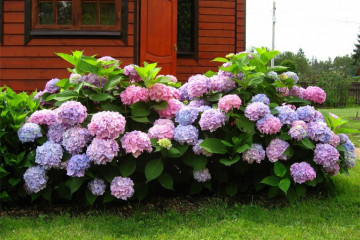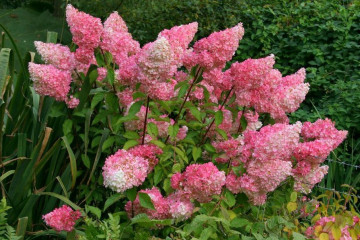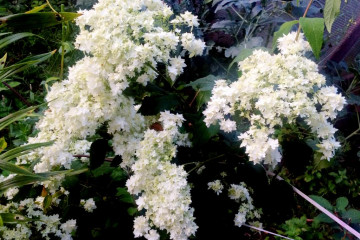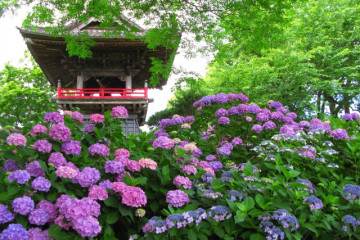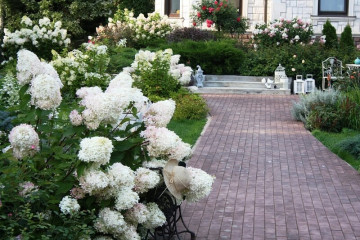Hydrangea blue or blue - planting and care in the open field
Content:
Hydrangea as a garden shrub is gaining more and more popularity from year to year. In the Moscow region, on a private territory, you can find milky inflorescences, less often panicles of a different shade. Blue hydrangea is not the result of selection, but the conditions for caring for the plant. But not all of its varieties are able to change color.
Hydrangea blue or blue
The hydrangea paniculate blue or white gained popularity due to its long flowering. Therefore, the flower is called by many as "eternal summer". The blue color is often given to large-leaved, garden hydrangeas.
Origin and appearance of plants
The earliest information about the plant dates back 40-70 million years ago, the homeland of the hydrangea is North America. In Asia, it appeared much later, about 25 million years ago. The flower was brought to Europe only in the 18th century, the first species is tree-like.
It is not difficult to recognize the plant: the height is up to 1 m, on the stem there are large heart-shaped leaves of a uniform green color. At the end, large inflorescences connected in a hemisphere up to 25 cm in size. Flowering continues from mid-June until the arrival of the first frost, after which the vegetative part dies.
Plant flowering descriptions
If you look closely, each inflorescence is a collection of small elements that look like a container for liquid. For this plant, and got its name. Translated from Latin, it means "a vessel with water." In the central part, a box with seeds ripens by the end of the season. On the periphery, the flowers are sterile.
The appearance of the flower depends on the variety. The panicle hydrangea has a wide base and a conical shape up to 25 cm in length. The elements of the inflorescence are up to 30 mm each, they consist of four petals, they are sterile.
The tree-like variety differs in height, it reaches up to 3 m. The plant has oval leaves about 20 cm long, panicles consist of small flowers. The stems need to be pruned annually. Hydrangea tree-like blue does not occur in the garden, this species is not subject to staining.
Types and varieties
In addition to belonging to plant species, each has several varieties. They differ not only in appearance, but also in the degree of capriciousness, requirements for content.
Minnie Penny
This variety, like the Prince, belongs to the garden species. There is a large-leaved blue and pink hydrangea. The plant tolerates partial shade well, is compact in size. The height of the shoots reaches 80 cm. The variety is resistant to fungal attack.
Ramars
They also call it Laguna. The bush loves high humidity, requires spraying. It tolerates partial shade well, belongs to the multi-colored varieties.
Freedom
This variety prefers shade. The leaves are dark green in color, the inflorescences do not exceed 15 cm in diameter. The peculiarity of the variety is the color change in one season: at the beginning of summer, the inflorescences acquire a pink tint, then turn into blue.
Compeito
Flowers of this variety are distinguished by their lilac-blue color on the periphery and white in the center. It was launched in 2007 in Japan. This species also loves moisture, so it is recommended to irrigate the bushes. The shoot contains many small flowers up to 5 cm each.
Nikko Blue
This variety belongs to the large-leaved hydrangea. The maximum height of the bush is 1.5 m. The leaves are oblong, serrated.
Greens grow quickly, Blue hydrangea takes on a shade of flowers depending on the acidity of the soil: at a low value - pale blue, high - blue.
Performance
This option refers to chameleons: it starts the season with pink, then turns into blue. It is a remontant variety, due to which it is possible to bloom again in a year. Refers to frost-resistant varieties. If early flowering is expected, then it needs shelter.
Jomari
Flowers of this variety are large, double. The height of the bush reaches 90 cm, which characterizes it as miniature. The leaves are large, oblong. Flowering begins on the shoots of the second year of growth.
How to make hydrangeas blue at home
How to care for a blue hydrangea in the garden so that it will delight you with regular flowering? It's important to follow simple rules. Compliance with the care recommendations will also allow you to change the color from white to blue or its shades.
The first stage is the correct planting of the plant in the ground. You can plant a bush in spring or autumn, which is not of fundamental importance. If you do this after winter, then only when the snow melts and the soil warms up a little.
Watering mode
Hydrangea blue in most cases requires regular abundant watering. In addition, irrigation of greenery is also encouraged. To ensure the optimal humidity parameter, you need to choose the right substrate. It is best to choose a mixture of sand, peat, humus and rotten foliage in a ratio of 1: 1: 2: 2.
Hydrangea is blue, planting and care in the open field involves watering 1-2 times a week. When the greenery withers, it is enough to bring water under the bush, and it will come to life. In summer, the watering regime is increased up to 3 times a week. Irrigation of 1 bush requires about 20 liters of water.
Mineral addition
For the first two years, the bush does not need additional nutrition, since it is initially planted in prepared soil.
Plant feeding should be carried out up to three times during the active period. The first stage - after waking up, the second - before budding, approximately in May. The third time Blue hydrangea is fed at the end of the season (in August-September). After the formation of buds, fertilizer is reintroduced.
The first culture medium should contain nitrogen, phosphorus and potassium. Fertilization of the second stage should consist of:
- superphosphate 2 parts;
- 1.5 parts of urea;
- potassium sulphide.
The third top dressing may be based on manure or chicken droppings. The plant also likes lactic acid, so whey, kefir, yogurt can be added to the soil.
If you add an excessive amount of top dressing, then the abundant flowering will cause breakage of the stems.
Care features
To grow a plant in the Volga region, you need to know how to properly care for it during the active period. This is the most crucial moment. The bush during this period needs loosening of the soil, weeding, feeding and timely watering.
Features of care during the rest period
After flowering, it is necessary to maintain comfortable conditions for keeping the plant. If this is a decorative option, planted in a pot, then it is rearranged on the windows facing west.In the open field, the plant, if the variety is not frost-resistant, requires insulation. He needs a temperature of 8-10 ° C.
Before the start of active growth, the bush must be cut off. April is best suited for this, before the start of the growing season. Old stems are cut at the root, dry flowers are removed.
Thus, blue hydrangea is several varieties of flowers that change color under certain conditions. The plant loves high levels of humidity, prefers semi-shaded areas. In the active period, flowers need watering, irrigation and fertilization.




